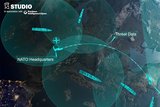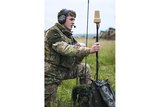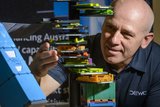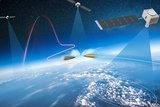Why space-based assets are crucial for effective missile defence (Studio)
Brought to you in partnership with Raytheon Intelligence & Space
Against the backdrop of rising ‘peer’ and regional state rivals, the US and its allies are increasingly focused on effective missile defence.
While this depends on components across different domains, space-based assets will be crucial.
Raytheon Intelligence & Space (RIS) is a crucial provider of technologies in this domain.
Among a range of other work, the company is developing the Future Operationally Resilient Ground Evolution (FORGE) Mission Data Processing Application Framework (MDPAF) for the US Next-Generation Overhead Persistent Infrared (Next Gen OPIR) resilient missile warning satellite, as well as for the Lockheed Martin-led Space-Based Infrared System (SBIRS) missile warning satellite.
The company is also partnered with Northrop Grumman in the Next Generation Interceptor (NGI) programme.
According to Rob Aalseth, RIS’s Director for Missile Warning and Missile Defense Programs, adding a space layer in missile defence isn’t an optional extra – it is crucial.
‘The largest leap in capability that you get in these architectures – by an order of magnitude – is when you add a space layer,’ he said.
‘It buys you so much mission response time, and it’s global, meaning you’ve got eyes everywhere, all the time.’
There is a new emphasis on layered defence within the US Space Force and the Department of Defense more broadly, with an erosion of the barriers between missile warning technologies and the Ballistic Missile Defense System (BMDS).
The shifting threat picture is driving this, Aalseth said. While historically such threats were ballistic, now they include hypersonics and a range of other non-ballistic systems.
Aalseth expects to see increasing collaboration between the Space Force and the Missile Defense Agency (MDA), focusing on combined, layered architectures of interwoven sets of capabilities. Raytheon adopts a similar, holistic picture, he said, encompassing everything from sensing to tracking to effectors.
In the past, a system like SBIRS was seen as the ‘eyes in the sky that initiated the bell ringer’ to warn of threats, he said.
In the future, space will provide a growing ability to not only ‘ring the bell’ but also to understand the trajectory and dynamics of the threat, boosting the effectiveness of radars and effectors such as missiles.

Layered missile defence in the 21st Century demands greater vision and precision than ever before, according to Melissa Morrison Ellis, RIS’s director for NGI.
She said a layered system relies on technologically advanced sensors and command and control (C2) systems, with an outlook stretching to decades into the future.
This requires an increasingly interwoven acquisition approach in the US and deeper collaboration with its allies.
‘We’re being asked to look at threats 30 years in advance, from short-range missiles to hypersonic warheads,’ she explained.
‘It’s no simple feat, and when it comes to that level of missile defence, no nation and no system can stand alone.’
Different operators have different needs, as well as varying budgetary limitations.
Aalseth explained that RIS and Raytheon Missiles & Defense deploy advanced modelling and simulation technologies that incorporate data in everything from constellation design to radar and effectors, based on deep experience in all of these areas from across Raytheon Technologies.
Using these models, it is possible to examine a capability from many perspectives, including price,ensuring a particular customer gets the missile defence they need.
‘There are elements of space architectures where you get a lot more bang for your buck over other space architectures, and we’re able to show that to our customers and help them make better, more informed decisions,’ Aalseth explained.
‘That is key to the work we’ve been doing.’

As one of the world’s leading defence and advanced technologies providers, Raytheon can also exploit the research and development it pioneers in other areas – such as aircraft and sensor development. The company can then apply these technologies to the space-based missile defence domain, a key advantage in the layered approach.
‘We’re able to harvest a lot of the technology from other programmes that we support, even other parts of our business,’ Aalseth noted.
Raytheon is also working to develop tighter relationships and an increasingly joint approach in its own organisation, building stronger links not just between its different businesses but across its operations in other geographical regions.
The ultimate goal is to build the most advanced, dependable technology for customers, said Morrison Ellis.
Space is a harsh environment, and customers demand highly reliable vehicles to overcome the challenges they face. Even a stray particle can cause problems in the zero-gravity environment, she said.
Raytheon has world-leading facilities dedicated to developing and testing the technology that underpins success.
‘We need to make sure – we will make sure – that everything works in advance of that mission.’
More from Space Solutions Special Report
-
![Delivering Space Solutions - the Crucial Layer for Missile Defence (video)]()
Delivering Space Solutions - the Crucial Layer for Missile Defence (video)
Against the backdrop of rising ‘peer’ and regional state rivals, the role of space-based assets for effective missile defence will be critical.
-
![British Army embraces SlingShot]()
British Army embraces SlingShot
Add-on kit turns UHF/VHF radio into a BLoS solution to support voice and data communications.
-
![Delivering Space Solutions - the New Digital Engineering Paradigm (video)]()
Delivering Space Solutions - the New Digital Engineering Paradigm (video)
Digital engineering is transforming the defence industry, from design to manufacturing.
-
![Digital engineering: a new era of manufacturing (Studio)]()
Digital engineering: a new era of manufacturing (Studio)
The digital engineering concept creates an environment where a single, digital source of truth empowers defence manufacturing.
-
![DEWC Systems takes MOESS sensor development to next stage]()
DEWC Systems takes MOESS sensor development to next stage
The MOESS programme intends to deploy a sovereign Australian tactical electromagnetic sensor capability, installed on a constellation of CubeSats. DEWC is developing a sensor that can conduct radar electronic support in defence-relevant radio frequency bands used by assets such as ships and aircraft.
-
![MDA unlocks key challenge to advanced ballistic missile tracking]()
MDA unlocks key challenge to advanced ballistic missile tracking
The US is progressing with its HBTSS project, having overcome an important obstacle.
























